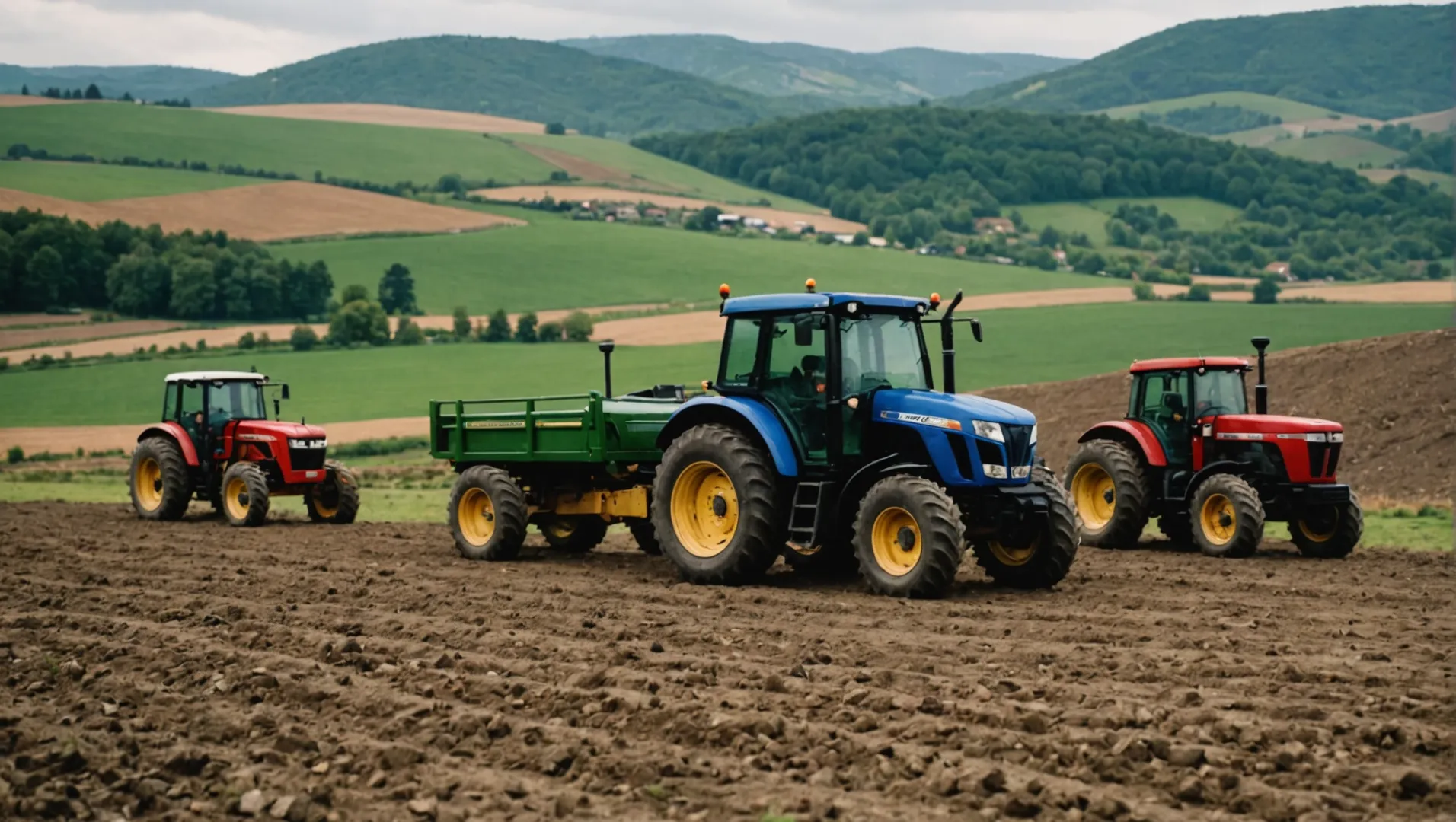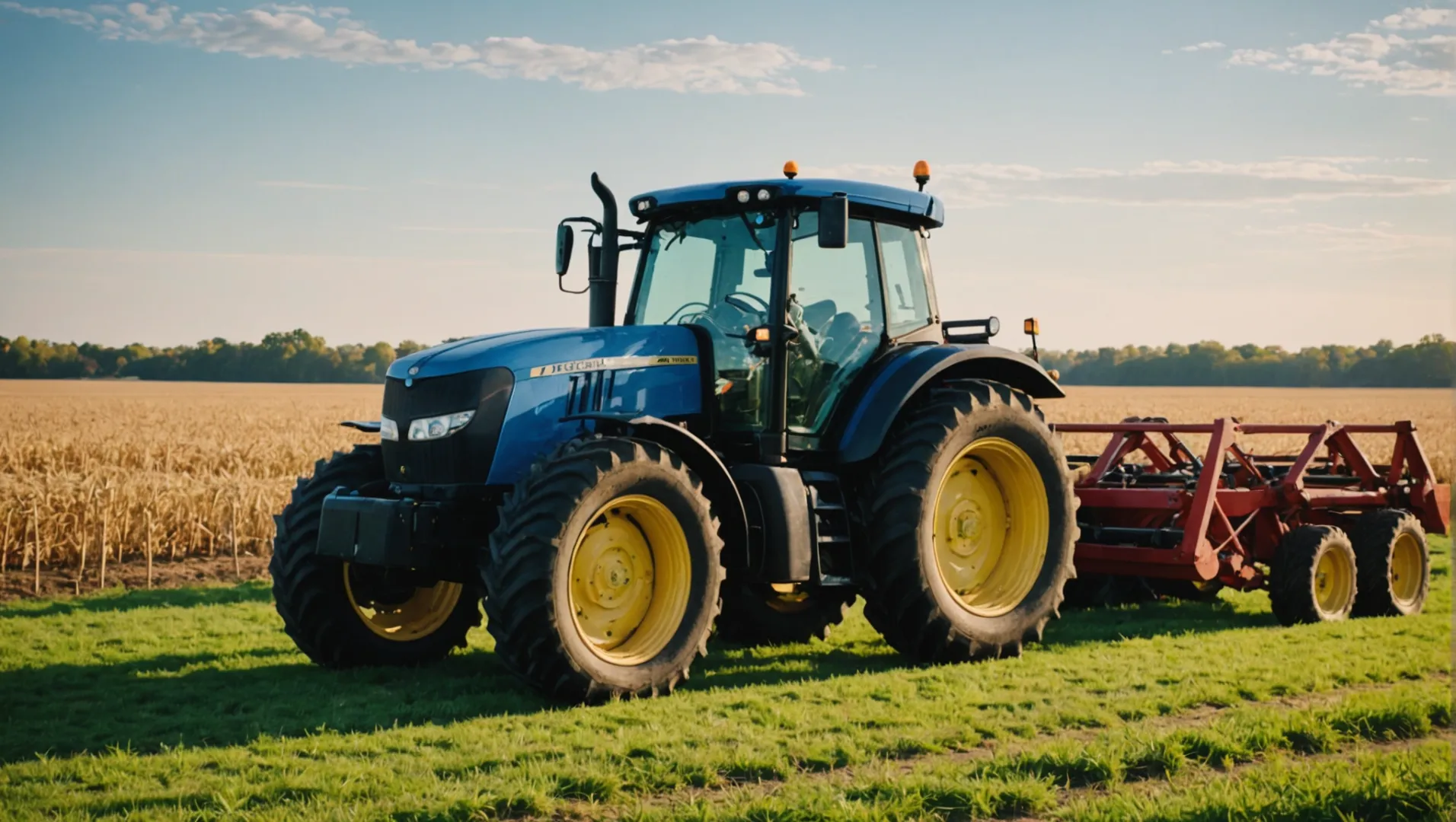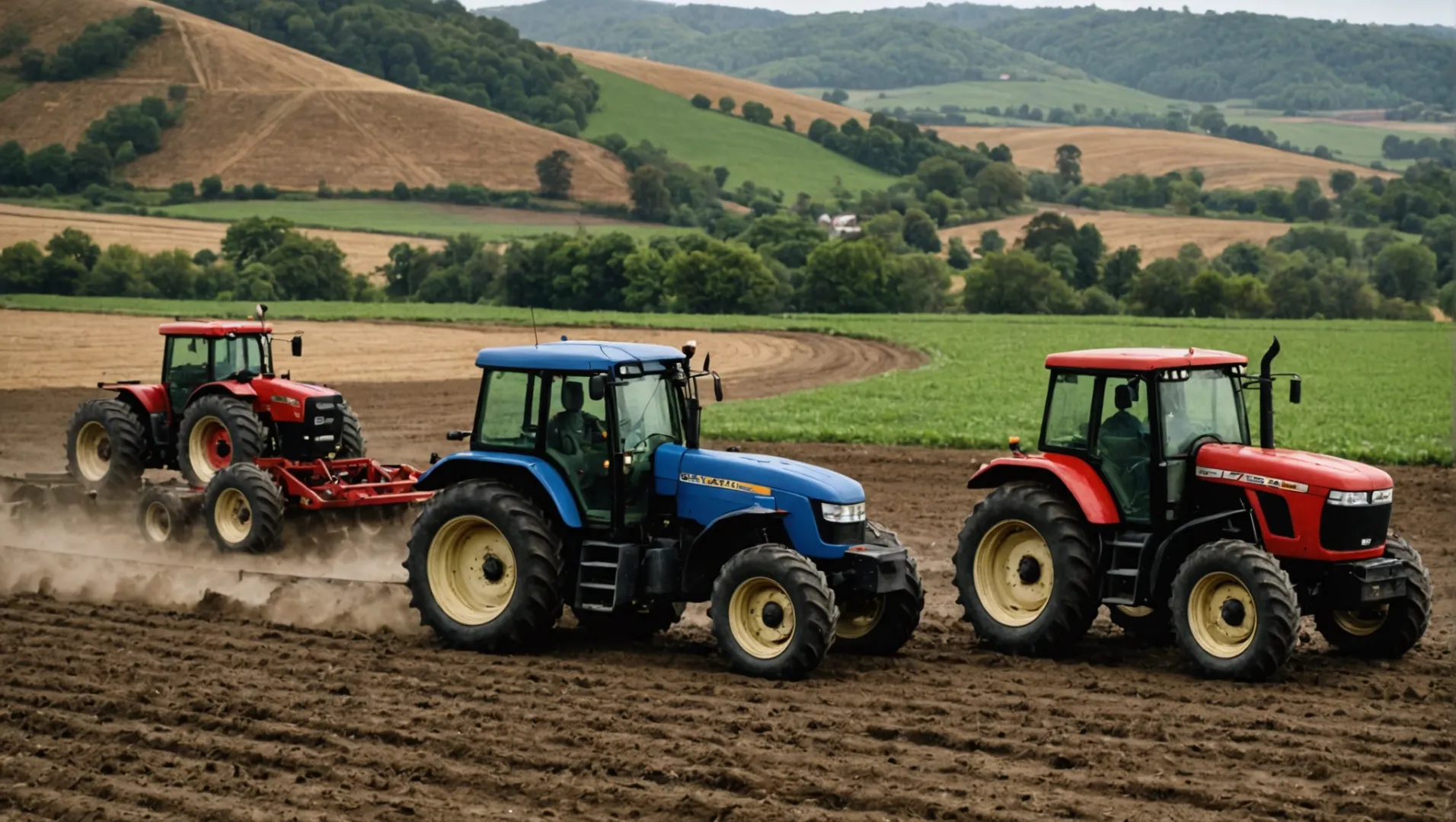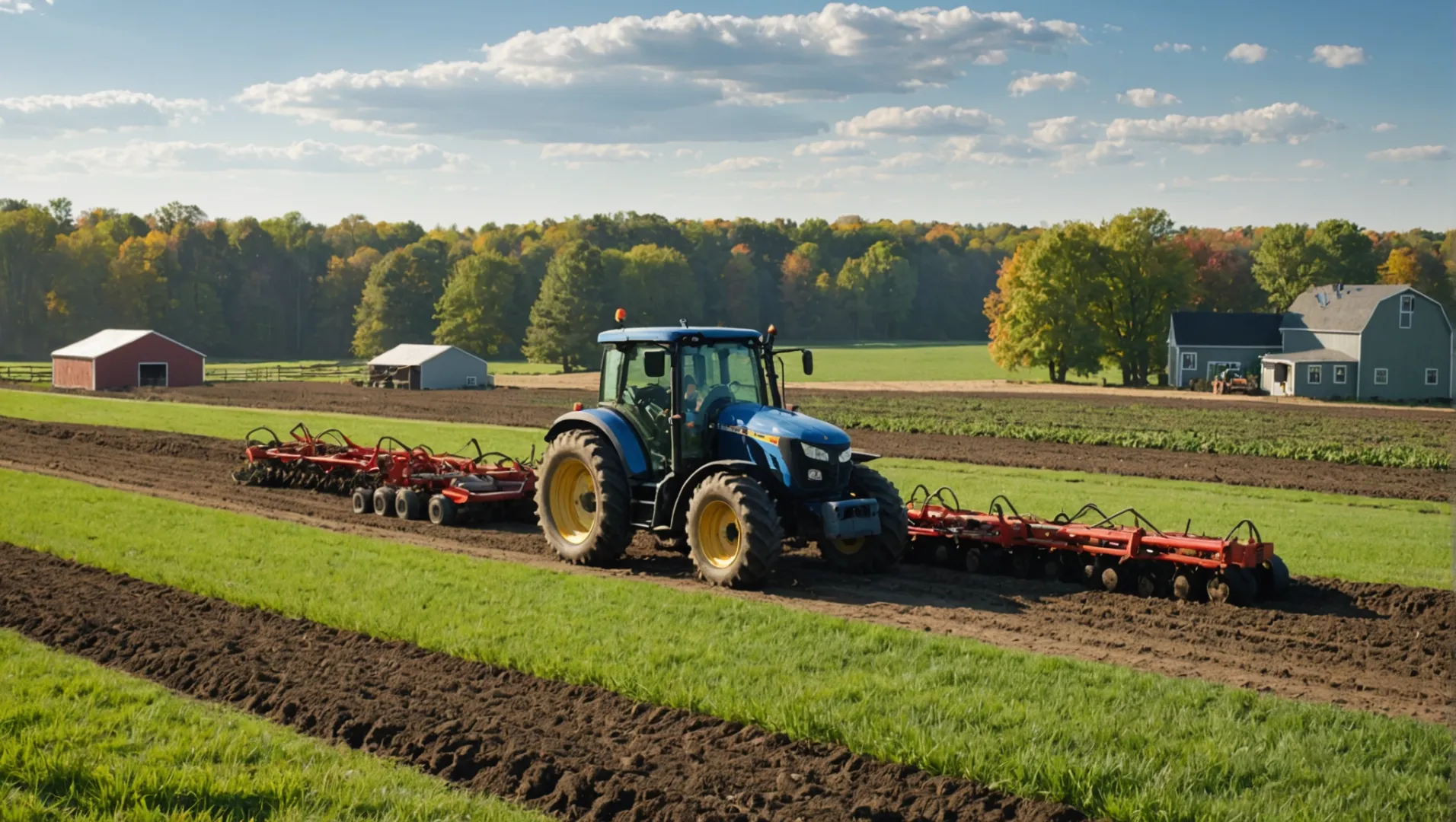Running a 10-acre farm might feel like having your own piece of paradise - or a mess. The right tractor helps keep everything perfect.
For managing a 10-acre farm, a tractor with 30 to 50 horsepower is generally suitable. This range provides enough power for essential tasks like mowing, tilling, and light plowing while remaining cost-effective.
Now, let us examine what creates this range and how to adjust it for your special piece of paradise. Look into terrain details and important aspects to choose wisely.
A 30 to 50 horsepower tractor is ideal for 10-acre farms.True
This horsepower range manages key duties like cutting grass and tilling soil well.
How Does Terrain Affect Tractor Size Selection?
Picking the correct tractor size for your land involves more than just strength - terrain is a key factor in this choice.
Terrain affects tractor size by determining power requirements and mobility. Hilly or rough terrains necessitate more horsepower and robust traction systems, like 4WD, to handle steep slopes and uneven grounds effectively. In contrast, flat terrains can accommodate smaller tractors with less horsepower, focusing on efficiency over power.

Understanding Different Land Types and Their Challenges
Choosing a tractor depends a lot on the land type at your farm. Here are some usual land types and the problems they bring:
-
Flat Land: Usually easy to handle, flat areas work for smaller tractors with less power. These places focus on doing the job well and saving fuel rather than needing lots of power. However, soil types can change, and heavy clay or sandy grounds might need special tools.
-
Hilly or Sloped Land: These need tractors with more power to go up hills safely. A four-wheel-drive system1 is important here to provide the needed grip and avoid slipping, especially with heavy loads.
-
Rocky or Uneven Land: These places need strong tractors with high ground clearance and tough tires. Rocks can shake the tractor a lot, so it must handle rough use.
Power Needs Based on Land Type
In general, harder lands need more power. Here’s a simple guide:
| Land Type | Suggested Power |
|---|---|
| Flat | 30-40 HP |
| Hilly/Sloped | 50-70 HP |
| Rocky/Uneven | 60+ HP |
This table offers a basic idea, but actual needs might differ depending on extra things like soil type, weather, and natural barriers like trees or streams.
Factors for Different Lands
-
Grip Systems: For wet or muddy lands, a 4WD tractor keeps stability and grip.
-
Tool Compatibility: Check if the tractor size works with needed tools like mowers, tillers, or loaders. For hilly lands, pick tools that spread weight properly to stop tipping over.
-
Fuel Use vs. Power: On flat lands, picking a smaller tractor can cut fuel spending without losing performance. But for tough lands, power is more important than saving fuel to do the job well.
Knowing these factors helps in choosing the right tractor size for your land's specific issues.
Flat terrains require tractors with less than 50 HP.True
Flat terrains remain simpler to handle, requiring 30-40 HP.
Hilly terrains do not need four-wheel drive.False
Hilly lands require 4WD for grip and security on hills.
What Are the Key Features to Look for in a Farm Tractor?
Selecting the best features in a farm tractor is important for improving productivity and efficiency on your farm.
Key features to look for in a farm tractor include engine power, transmission type, hydraulic capacity, PTO, and comfort options. These features ensure versatility and ease of use for various agricultural tasks.

Engine Power and Performance
The engine is the heart of your tractor. Selecting a tractor with adequate horsepower is essential for handling different farming tasks, from plowing to hauling. For example, a tractor with 30-50 horsepower might be ideal for light tasks, while heavy-duty operations may require over 100 horsepower.
Consider the terrain and the implements you'll use to decide the power range that suits your needs.
Transmission Types
Transmission options affect how your tractor operates. There are typically three types:
- Manual Transmission: Offers more control but may require more skill to operate.
- Automatic Transmission: Easier to use but might limit control in complex operations.
- Hydrostatic Transmission: Provides smooth operation, ideal for variable-speed tasks.
Evaluate these options based on what feels comfortable and how difficult the tasks are.
Hydraulic Capacity
Hydraulics play a vital role in operating attachments like loaders or plows. A higher hydraulic flow rate can power larger attachments more effectively. Ensure the hydraulic system satisfies the needs of the implements you'll be using2.
Power Take-Off (PTO)
PTO ratings matter for using powered tools like mowers or sprayers. Consider the type (independent or live) and power output to ensure compatibility with your equipment.
Comfort and Ergonomics
Long hours on a tractor mean comfort is key. Look for features such as adjustable seats, climate control, and ergonomic controls to reduce fatigue and increase productivity. Some models provide GPS and precision technology, possibly raising efficiency even more.
Versatility and Attachments
A versatile tractor can handle multiple attachments, increasing its functionality. From loaders to backhoes, consider what attachments are essential for your farm's operations and ensure compatibility with your tractor model.
Fuel Efficiency and Maintenance
Choose models known for good fuel efficiency to cut costs. Look into maintenance requirements so your tractor remains reliable over time with minimal downtime.
By focusing on these key features, you can choose a tractor that aligns with your farm's specific needs, maximizing both productivity and cost-effectiveness.
Tractors with over 100 HP are for heavy-duty tasks.True
Strong tasks need tractors with over 100 horsepower.
Hydrostatic transmission limits control in complex tasks.False
Hydrostatic transmission supplies smooth functioning, perfect for changing speeds.
Should You Choose a 2WD or 4WD Tractor?
Choosing between a 2WD and 4WD tractor may greatly influence how your farm functions and produces. Which one fits your farm more?
Choosing between a 2WD and 4WD tractor depends on your farm's terrain and task requirements. A 2WD tractor is cost-effective and suitable for flat terrains, while a 4WD offers better traction and performance on uneven or slippery surfaces.

Knowing the Land and Job Needs
When looking at tractor choices3, think about your land and the jobs you need to do. A 2WD tractor often works well on flat, dry farms where pulling heavy loads is not needed. It does jobs like mowing or planting well without the extra cost of 4WD.
But, if your farm has hills or muddy fields, a 4WD tractor gives better grip and steadiness, lowering the chance of slipping and improving work speed.
Thinking About Costs
Money limits often shape whether to choose a 2WD or 4WD tractor. A 2WD tractor is often cheaper to buy and fix because it has fewer parts.
But, buying a 4WD might save money in the long run if your farm needs regular work on tough terrain, because it reduces damage to tires and hard soil.
| Feature | 2WD Tractor | 4WD Tractor |
|---|---|---|
| Land Fit | Best for flat, dry areas | Great for uneven, muddy land |
| Cost | Lower starting cost | Higher starting price |
| Grip | Limited grip | Better grip |
| Flexibility | Good for simple jobs | Excellent for tough, varied jobs |
Thinking About Farm Jobs
Think about the jobs you often do. If they mainly involve light work like moving4 tools or goods on flat land, a 2WD might be enough. But for hard work like plowing or carrying heavy things over different lands, a 4WD’s strength and grip are very important.
Knowing these differences helps choose what fits your farm’s needs, improving output and work speed.
2WD tractors are best for flat, dry lands.True
2WD tractors are affordable and perform excellently on level, dry land.
4WD tractors have lower initial costs than 2WD.False
4WD tractors probably cost more at first because they use new technology.
Which Attachments Are Essential for a 10-Acre Farm?
Picking the suitable gear for your 10-acre farm helps increase productivity and efficiency. Which essential tools should you think about?
Essential attachments for a 10-acre farm include a plow for soil preparation, a mower for field maintenance, a loader for material handling, and a seeder for planting. These tools equip farmers to handle basic tasks efficiently, maximizing the utility of their tractors.

The Importance of Soil Preparation Tools
One of the first tasks on a farm involves soil preparation. A plow5 is vital for breaking and loosening the soil to get it fit for planting. For smaller spaces, a tiller might suffice, but a plow digs deeper, which helps in compacted soils.
A harrow complements the plow by refining the soil texture, breaking up large clods, and ensuring even distribution of organic matter. This step is crucial for creating a fine seedbed, which promotes better seed germination and crop yields.
Efficient Planting with Seeders and Planters
A seeder or planter allows seeds to be sowed rapidly and uniformly. This tool places seeds at the proper depth and spacing for good growth. On a 10-acre land, a small or medium-sized seeder works well for grains and vegetables.
Keeping the Farm Neat with Mowers
Mowing is more than just aesthetics; it helps control weeds and prevent pest infestations. A rotary mower can be attached to your tractor to keep grass under control, particularly near crops, to reduce competition for nutrients.
Loaders: Versatile Attachments for Various Tasks
A front-end loader ranks among the most flexible tools available. It moves soil, gravel, feed, and materials easily. Clearing debris or transporting items around the farm becomes simpler with a loader, saving hours and effort.
| Tool | Main Use | Advantages |
|---|---|---|
| Plow | Soil preparation | Deep digging, airflow |
| Harrow | Soil refinement | Breaks clumps, smooths fields |
| Seeder | Planting | Consistent seed spreading |
| Mower | Field upkeep | Weed control, pest prevention |
| Loader | Material movement | Flexibility in farm tasks |
Thoughts on Sprayers and Balers
According to crop type, a sprayer helps in spreading pesticides or fertilizers properly. This tool gives even coverage, vital for protecting plants and encouraging growth.
For hay production, a baler proves very useful. It packs cut grass into bales, easing storage and moving. On a 10-acre land with animals, it really simplifies feed handling.
Picking the proper tools increases tractor capability and guarantees smooth work across different farm tasks.
A plow is essential for soil preparation on a 10-acre farm.True
A plow turns and loosens the soil, preparing it for planting.
A baler is necessary for every 10-acre farm with no livestock.False
Balers are mostly necessary when the farm creates hay, often for animals.
Conclusion
Know what your farm requires and balance strength with usefulness for good land care. Try different models to locate the best match.
-
Learn why 4WD tractors excel on challenging terrains.: These models can offer impressive power and traction. They are mechanical workhorses able to handle difficult agricultural projects. ↩
-
Discover essential equipment utilizing hydraulics for enhanced farm efficiency.: Power of Hydraulics in Agriculture Equipment · Agricultural Equipment · Tractors · Combine Harvesters · Sprayers · Track Loaders · Self-Propelled ... ↩
-
Learn about specific advantages of both 2WD and 4WD tractors.: The primary advantage of using a 2WD tractor is its small turning radius, uncomplicated design, and affordability. Smaller models within the 2WD range are ... ↩
-
Discover how tractors are used for transporting farm equipment efficiently.: Tractors are high-traction vehicles used for various farming operations. They are fitted with multiple attachments that help them perform any ... ↩
-
Understand various plow types suited for small-scale farming.: Types of Tractor Plows · Moldboard Plow · More videos on YouTube · Reversible Garden Plow · Chisel plows · Disc Plows · Sub-Soiling Plow. ↩




